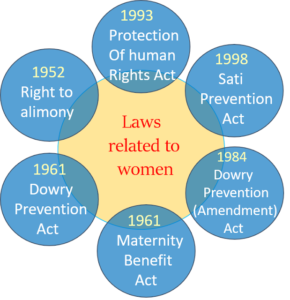| [popup_anything id=”6438″] |
1. Complete the statements by choosing the proper option.
(1) In 1992, a movement against drinking alcohol was started in ……………….…………
(a) Maharashtra (b) Gujarat (c) Andhra Pradesh (d) Uttarakhand
Ans. Andhra Pradesh
(2) In 1975, the government of India formed the Committee on the Status of Women under the chairmanship of …………………..…………
(a) Dr. Phulrenu Guha (b) Uma Bharati (c) Vasundhara Raje (d) Pramila Dandavate
Ans. Dr. Phulrenu Guha
2. Identify the wrong pair and rewrite the corrected one.
(1) Saudamini Rao – Stree-Mukti Andolan Samiti
(2) Vidya Bal – Nari Samata Manch
(3) Pramila Dandavate – Mahila Dakshata Samiti
(4) Jyoti Mhapsekar – Women’s Commission
Ans.
Wrong pair: Jyoti Mhapsekar – Women’s Commission
Corrected one: Jyoti Mhapsekar – Street play Mulgi jhaali Ho
3. Make a concept chart :
Laws related to women.
Ans.
4. Explain the concepts :
(1) Alimony
Ans. Alimony is the fixed amount paid to a married woman for her upkeep by the husband who has divorced her. Alimony laws are different for different religions in India.
(explanation)
(2) Minority
Ans. In any society, a group of people of a particular religion, language or race who are few in number are termed as minority. (explanation)
5. Explain the following statements with reasons.
(1) The women’s liberation movement began.
Ans.
(1) The United Nations declared 1975 as the International Women’s Year.
(2) In 1975, the government of India constituted the Committee on the Status of Women and appointed Dr Phulrenu Guha as its Chairman.
(3) A Comprehensive study indicated gender-based discrimination.
(4) A State-wide conference for women was held in 1975 organised by the Stree-mukti Sangharsha Samiti.
(5) The Samiti published its manifesto in 1978. The policy of a struggle against discrimination on the basis of gender, caste and varna was adopted.
As a result, women’s liberation movement began.
(2) The Prohibition of Dowry (Amendment) Act was enacted in 1984. (explanation)
Ans.
(1) Even after the enactment of the anti-dowry law, incidents like ‘Woman burns to death as sari pallu catches fire while cooking’ and ‘Woman slips into well while washing clothes, drowns and dies’ continued to be reported.
(2) Investigations still revealed dowry to be the most frequent cause of such deaths.
(3) As a result, the Dowry Prohibition (Amendment) Act came into force in 1984. (explanation)
(3) The practice of untouchability was banned by law.
Ans.
(1) In the post-independence period, our Constitution adopted the values of freedom, equality, fraternity and social justice.
(2) But the practice of untouchability was stain on the Indian society.
(3) Therefore untouchability was removed by the 17th paragraph of the Constitution.
(4) The Constitution gives cultural and educational rights to minorities.
Ans.
(1) As there are various religions, sects and languages in our country, we see great cultural diversity.
(2) There is variation in cultural traditions, too.
(3) In order to preserve their cultural traditions and develop their own language, the Constitution gives cultural and educational rights to minorities.
(4) They have the right to set up separate educational institutes and seek government support for the same.
6. Answer the following questions in 25 to 30
(1) Describe the Chipko movement.
Ans.
(1) Trees from the forests in the foothills of the Himalayas were to be cut down for commercial purposes.
(2) Chandiprasad Bhat and Sunderlal Bahuguna had started a movement to prevent this.
(3) Women followed the strategy of holding hands and encircling each tree.
(4) As their method consisted of protecting the tree by embracing it, the movement came to be known as the Chipko movement.
(2) Write a note on the Protection of Human Rights Act.
Ans.
(1) In 1993, Protection of Human Rights Act was enacted to prevent injustice to men and women.
(2) The National Human Rights Commission was also formed for this purpose. In some States, the State Human Rights Commission was also formed on the same lines.
(3) This law which deals with collective oppression, the social conditions of divorced women, women and secure work places, played an effective role in mitigating injustices to women.
7. Answer the following question in detail.
Explain with examples how the united strength of women can bring about constructive changes in various fields.
Ans.
The united strength of women can bring about constructive changes in various sections of the society for example:
(1) Laatne Morcha (1972): Under the leadership of Mrinal Gore in Mumbai against the scarcity of commodities and price rise give the public a glimpse of United women power
(2) The Chipko Movement (1973): Women took an active part in the Chipko Movement by holding hands and encircling each tree to prevent their chopping for commercial purposes.
(3) Anti Liquor Movement (1992): The Women in Andhra Pradesh came together to protest against rampant alcoholism and were supported by the Sate government.
These moments saw great success and proved how united strength of women can bring about a positive change in the society.